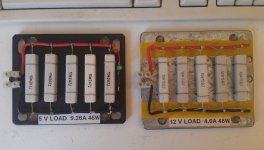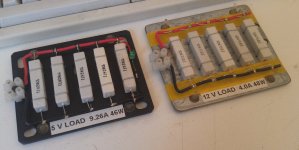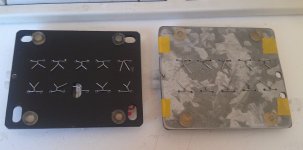Old Computers
Veteran Member
After having put this project on a long hiatus I have finally decided to try and finish up my PDP-11/44 restoration.
So a quick recap of what was being done:
The system would initially not turn on. A capacitor was replaced on the Bias and Interface board, and then the system would power on. The system would work, but then the power light started to flash indicating that a voltage was out of tolerance. The +5V and +5VB were considered suspect at the time. I started to build a dummy load for the system, but never got it finished.
Here is the original thread describing what was done before: http://www.vcfed.org/forum/showthread.php?32576-PDP-11-44-Restoration
Now I have been debating a few different paths to take from here. 1) Shotgun replace all the capacitors in the PSU (especially the Bias and Interface board), 2) build the dummy load and observe the system under the test conditions some more, or 3) source a replacement PSU or PSU boards if possible. I am also thinking about buying a couple of extender boards to get better access to the voltages to measure at the backplane.
I did pick up an ESR meter and have tested some of the capacitors on the boards. They all seem to be okay judging from the table, but the table is somewhat hard to interpolate if the capacitor is not really close to the listed values. I also did a check with a plain capacitance meter. One capacitor on the memory regulator board read a higher capacitance out of tolerance, but that might just be a result of being an in-circuit test. I am keeping that one in mind just in case.
I also managed to pick up the PDP-11/44 maintenance card which I didn't have access to before. It actually has brief troubleshooting steps for the DC ON light flashing. A couple of things it mentions are that D25 may be installed backwards on the Console Interface Module or a battery backup jumper may be installed on the backplane. I doubt its either of these since the voltages have been checked before, but I thought it might be worthwhile to check just in case. I found D25 on the CIM, but have no way to simply tell if it is backwards because there is no indication the board. I could probably trace the schematics if needed. As for the battery jumper, I don't think it is installed because as far as I know this system never had a battery backup unit. I also don't know where to find this jumper on the backplane.
Thank you for any pointers you may have.
So a quick recap of what was being done:
The system would initially not turn on. A capacitor was replaced on the Bias and Interface board, and then the system would power on. The system would work, but then the power light started to flash indicating that a voltage was out of tolerance. The +5V and +5VB were considered suspect at the time. I started to build a dummy load for the system, but never got it finished.
Here is the original thread describing what was done before: http://www.vcfed.org/forum/showthread.php?32576-PDP-11-44-Restoration
Now I have been debating a few different paths to take from here. 1) Shotgun replace all the capacitors in the PSU (especially the Bias and Interface board), 2) build the dummy load and observe the system under the test conditions some more, or 3) source a replacement PSU or PSU boards if possible. I am also thinking about buying a couple of extender boards to get better access to the voltages to measure at the backplane.
I did pick up an ESR meter and have tested some of the capacitors on the boards. They all seem to be okay judging from the table, but the table is somewhat hard to interpolate if the capacitor is not really close to the listed values. I also did a check with a plain capacitance meter. One capacitor on the memory regulator board read a higher capacitance out of tolerance, but that might just be a result of being an in-circuit test. I am keeping that one in mind just in case.
I also managed to pick up the PDP-11/44 maintenance card which I didn't have access to before. It actually has brief troubleshooting steps for the DC ON light flashing. A couple of things it mentions are that D25 may be installed backwards on the Console Interface Module or a battery backup jumper may be installed on the backplane. I doubt its either of these since the voltages have been checked before, but I thought it might be worthwhile to check just in case. I found D25 on the CIM, but have no way to simply tell if it is backwards because there is no indication the board. I could probably trace the schematics if needed. As for the battery jumper, I don't think it is installed because as far as I know this system never had a battery backup unit. I also don't know where to find this jumper on the backplane.
Thank you for any pointers you may have.



